Ελληνική έκδοση
The Sarakatsani Folk Museum in its present form is the result of 25 years of
persistent efforts, during which it passed through several phases and received
various awards. It was originally inaugurated in 1979 on the first floor of an
old mansion in Serres. Four years later, in 1983, the exhibition expanded to the
second floor as well, and the inauguration this time was combined with a
scientific conference, the first to be organized on the subject “Sarakatsani” a
Greek Nomadic Pastoral Population. The proceedings of this meeting, at which
fifteen papers were presented, were published in a 191-page volume in 1984.
In 1984 the Sarakatsani Folk Museum was honoured with the gold medal of the
Thessaloniki Rotary Club and in 1987 received a merit award from European Prix
du Musée de l'Année, marking its distinction as one of the 18 European Museums
selected from the 146 competitors.
The growing Greek and foreign interest in this specialist (monographic, to use
the terminology of modern Museology), Greek Folk Museum was accompanied by a
concurrent increase in its acquisitions, and a further round of efforts was
begun, aimed at acquiring new, purpose-built premises to rehouse it.
Thanks to understanding, interest and support from many quarters, and especially
the Hellenic Ministry of Culture, these efforts were succesful. Building of the
present premises commenced in 1991, on a plot of land made over by the state,
and in 1997 the Sarakatsani Folk Museum was inaugurated in a completely new
form.
The building is arranged on three levels: basement, ground floor and first floor
in the form of a gallery. The basement accommodates storerooms for the museum
collections not on display, a library and a small hall for cultural events and
instruction in Sarakatsani music and dance. On the ground floor and the first-floor
gallery an attempt has been made to convey, albeit significatively, the life and
art of the Sarakatsani during the final phase of their nomadic existence, that
is during the inter-war years and till the late 1940s, when World War II,
occupation by Axis forces and the civil war were the death knell for the tselingata.
It is impossible to portray all aspects of Sarakatsani life and art in the
available space, and the exhibition is restricted to its principal and most
formal manifestations.
On the ground floor the straw huts of different shapes and varied uses give a
concise picture of the life in the tselingato (temporary settlement). The
elaborately attired Sarakatsan woman and her festooned horse with its trappings
standing beside the tsiatoura (overnight shelter) alludes to the annual spring
trek of the Sarakatsani from the winter pastures in the valleys to the summer
meadows in the mountains.
At the centre of the hall is the "liarge hut", that is the Sarakatsani home,
its walls hung with brightly coloured patterned textiles, as it was for
weddings, kourbania and festivals in general. In one corner is the shepherd's
hut and the bantzos, where cheese was made. The accompanying photographs, plans,
drawings and texts complete the brief picture of a way of life that has
disappeared, never to return. MODEL OF A TSELINGATO
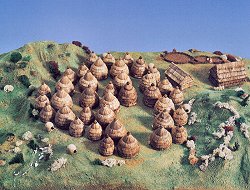 Model
of a tselingato, made by Vasilis Tsaousis. It gives a picture of the arrangement
of the huts within the rounding mountainous landscape. The tselingato was a
basic economic unit of the Sarakatsani. It was formed in groups of related
families who owned flocks, as well as non-kinsmen, the so-called smichtes. Model
of a tselingato, made by Vasilis Tsaousis. It gives a picture of the arrangement
of the huts within the rounding mountainous landscape. The tselingato was a
basic economic unit of the Sarakatsani. It was formed in groups of related
families who owned flocks, as well as non-kinsmen, the so-called smichtes. |
THE LARGE HUT
SEPHERD'S HUT
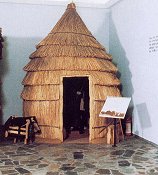
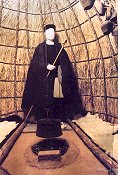 Sarakatsan
shepherd in his hut. Sarakatsan
shepherd in his hut. |
TSIATOURA The tsiatoura, a temporary
shelter of thick, densely woven woollen cloth. It was set up when the caravan
stopped for the night on the trek from the winter pastures to the mountains and
vice versa.
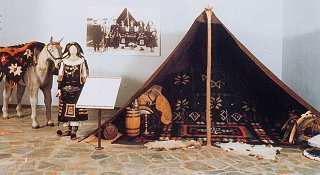 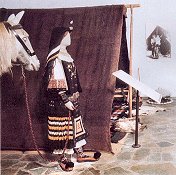
|
| Sarakatsan woman in festival
costume and the loaded horse, outside the tsiatoura. |
EDUCATION Next to
the tsiatoura is the school, with equipment borrowed
from a nearby village (until the autumn, when it was returned), noting the
Sarakatsani's need for rudimentary education at least, since a man had to know
reading, writing and arithmetic in order to become a tselingas (head of the
tselingato). It was in schools like this that Sarakatsani, who after the
dissolution of the tselingata became merchants, businessmen, scientists and
politicians, took their first lessons.
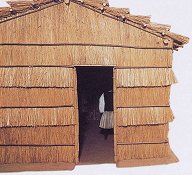 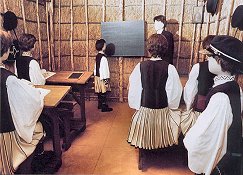
|
| The school. A rectangular straw hut, it operated only in summertime. The equipment and teacher came from a nearby village.
|
CHEESE-MAKING HUT
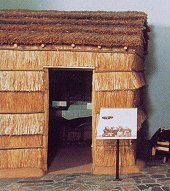 |
The rectangular cheese-making hut, the bantzos. |
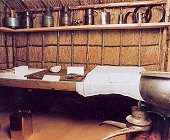 |
Interior view of the bantzos with the wooden bench where cheese is made. On the shelves lingeria, copper vessels of various shapes, for milk.
|
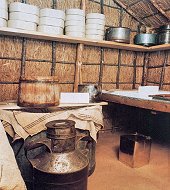 |
Interior view of the bantzos. The cauldron in which the milk was boiled and the large copper giou-mi are visible. On the shelf, row upon row of heads of kaskavelia, a distinctive Sarakatsan cheese. |
SARAKATSANI OLD PHOTOS
The exhibition on the first floor is devoted to Sarakatsan art, a mainly female
preserve, including textiles, embroidery and costumes. The large showcase on
spinning and weaving illustrates with photographs, texts and objects all stages
in the process of cloth production from shearing the sheep to weaving the home-spun
yarn on the loom, as well as multi-coloured woollen velentzes and cotton fabrics
for various uses. In the cases that follow there are accessories and jewellery
from the female costume, as well as ensembles of male and female garments from
various local versions of the Sarakatsan costume. Impressive is the
reconstruction of the costume of the Sarakatsan klepht (freedom-fighter) in the
Greek War of Independence (1821).
Lastly, displayed in the cases incorporated in the parapet of the balcony are
embroidered and knitted items, such as panaoules, stockings and kaplies, all
outstanding examples of the skilful handiwork of the Sarakatsan women.
CLOTH PRODUCTION
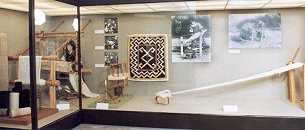 |
|
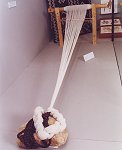 |
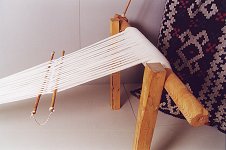 |
|
Part of the exhibit on yarn production. |
VELENTZES
Velentzes. Tufted woollen coverings with brightly coloured woven designs. Among the strictly standardized motifs the cross has obvious pride of place.
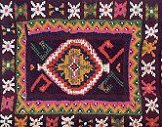 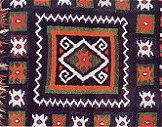 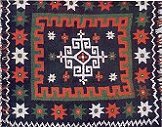
WEDDING
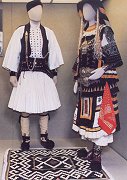 |
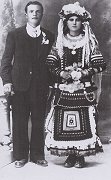 |
 |
|
Sarakatsan bride and groom. |
Photograph of a couple on their wedding day in the late 1940s. The bride is bedecked in the traditional costume, while the groom wears a European suit.
|
Scenes from the traditional wedding ceremony. The
xesakiasma, taking the dowry out of the bags in which it was brought. The bridegroom best friend jumping on the dowry. The
schariates the procession on horseback of the male relative of the bride and groom.
|
VARIATIONS OF THE SARAKATSANI COSTUME
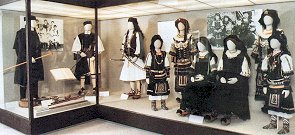 Part of the showcase with variations of the Sarakatsani
costume. Left to right: Sarakatsan man wearing a
potouri, Sarakatsan man wearing a segouni, klepht's costume, a group of costumes
worn by Sarakatsan women of different ages in Thrace. Part of the showcase with variations of the Sarakatsani
costume. Left to right: Sarakatsan man wearing a
potouri, Sarakatsan man wearing a segouni, klepht's costume, a group of costumes
worn by Sarakatsan women of different ages in Thrace.
|
SARAKATSAN FEMALE COSTUME
 Three regional versions of the Sarakatsan female costume. Left to right: Epirus, Thessaly and Central Macedonia - also known as the
"Kassandrini" costume. Three regional versions of the Sarakatsan female costume. Left to right: Epirus, Thessaly and Central Macedonia - also known as the
"Kassandrini" costume.
|
ΑΝΔΡΙΚΗ ΦΟΡΕΣΙΑ
Οι βασικοί τύποι της ανδρικής Σαρακατσάνικης φορεσιάς είναι:
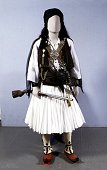 |
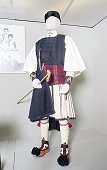 |
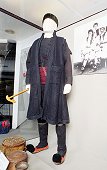 |
| Α) The
classic foustanella |
Β) Sarakatsan man wearing a segouni. Characteristic garments in the costume are the black jacket and narrow, white woollen kilt (foustanella) |
Γ) The
potouri |
THE KAPLIES
Kaplies, woollen textiles with hand embroidery and fringing. The elaborate standardized volute design covers the entire surface, arranged around the central, protective motif of the cross. The
kaplia was used as a horse blanket.
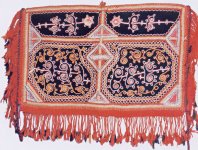 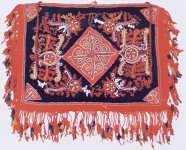
KLOUROTROVADES
Klourotrovades. Small, square bags of woollen cloth for carrying the wedding bread-rings. The multicoloured decoration, embroidered or applique with little pompoms and tassels, in the shape of a cross, has protective and apotropaic symbolism, basic to Sarakatsan motifs.
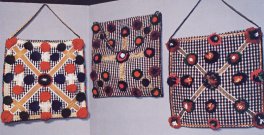 ΤΑΒΛΕΣ
The tavla, a long narrow, two-coloured cotton cloth embellished with applique pompons and braids forming crosses. It was laid on the ground for communal meals at feasts.
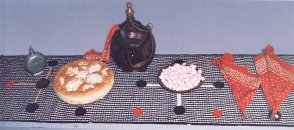 Placed on the tavla in the photograph are wedding objects and vessels such as wooden kofes for ouzo and wine, special bread rings (gambrokouloura), sweets (koufeta) and two kerchiefs passed through the betrothal rings. Placed on the tavla in the photograph are wedding objects and vessels such as wooden kofes for ouzo and wine, special bread rings (gambrokouloura), sweets (koufeta) and two kerchiefs passed through the betrothal rings. |
KNITTEN STOCKINGS
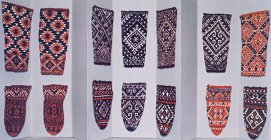 Women's knitted stockings and leggings (patounes) with applique decoration (kontosourapa). Women's knitted stockings and leggings (patounes) with applique decoration (kontosourapa).
|
PANAOYLES Panaoules or
panagoules. Characteristic little aprons of coarse woollen cloth embroidered by hand, worn by Sarakatsan women in Central Macedonia and Thrace. The decorative motifs not only have metaphysical symbolism but perhaps also denoted the wearer's social and age status.
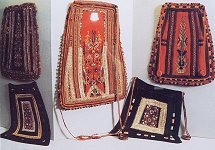 |

